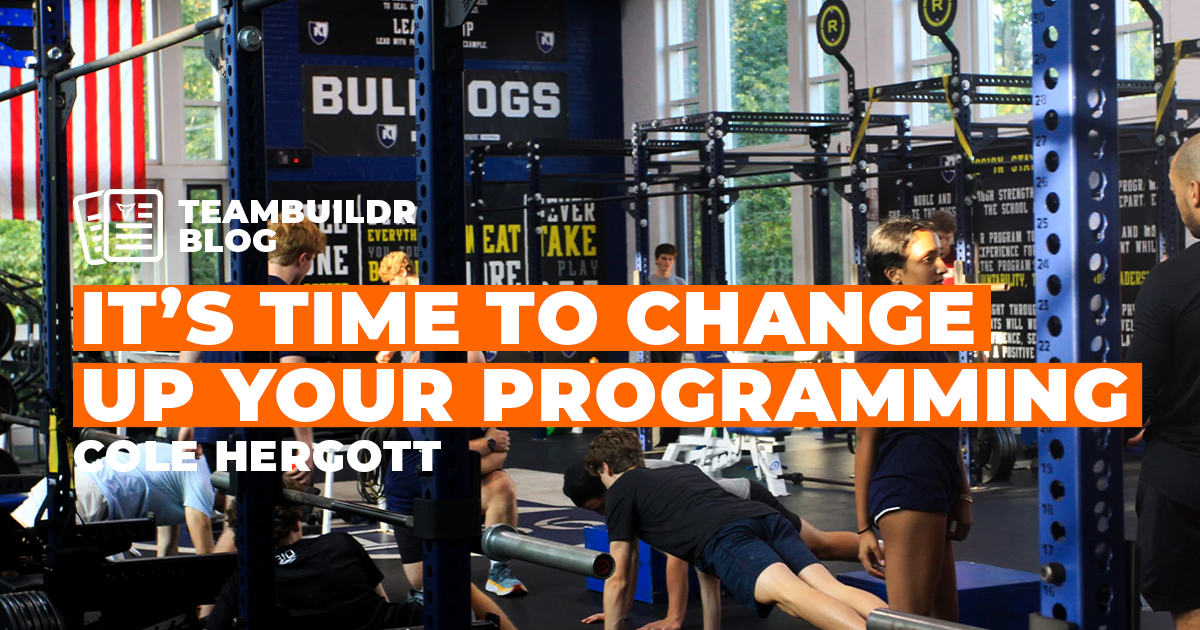Great strength & conditioning programming is supremely important for athletes. Not only can athletes make physical progress in their athletic abilities but also make impactful changes to their mindset, recovery methods, and overall health.
All of these elements can drive performance increases, injury reduction and help develop trust in the entire coaching staff. Whether you’re in the private setting or team setting, working with youth or professionals, the nucleus of optimal performance is the strength training program.
Want to get more out of your athletes? Here are 5 simple tips to write better strength and conditioning workout programs and ultimately move the needle to maximize performance gains.
1. Put More Emphasis on Movement Quality
Yes, we want to get after it in the weight room. Yes, we want to progressively overload our athletes. Yes, we want to get strong early and often! No, we do not want to do those things with poor mechanics, faulty technique or low quality of movement.
One of the biggest improvements you can make in your programming is putting more emphasis on movement quality without compromising the intensity of the lifts. There are a few different ways to emphasize movement quality without completely watering down the program with correctives, stretches and other things that won’t actually build strength.
First, you can alter exercise tempos. Namely, the eccentric phase of major lifts. Slow down the eccentrics for a two-fold benefit - strength development and movement clean-up. Tempo reps force the athlete to own the load, own the movement and can lead to major improvement of strength and function.
Another great option is to build accessory lifts into the program that revolve around common mistakes in technique. For example, many athletes lack the ability to properly brace their core during heavy squats and deadlifts. This not only throws off the form of the lift, but can leave the athlete at risk of injury due. Throwing in 3-4 sets of Dead Bugs, Pallof Press or Bird Dogs can help athletes develop core strength and simultaneously work on their bracing and breathing technique.
Of course, coaching up the athletes and providing feedback after each set is a major key to this equation too, but in terms of just program design the two tips above have been great for cleaning up movements and helping our athletes continue to move forward safely.
2. Individualize What You Can, When You Can
Many of you reading this will be able to implement this tip in various ways, some more than others. Depending on your role, setting, etc. program individualization may not be something you do a ton of. That being said, try to individualize what you can, when you can.
The importance of trying to find ways to individualize a program to an athlete’s needs and experience level is paramount. More than likely, your scrawny 130 freshmen is not going to have the same movement capabilities or work capacity as your 5-star recruit senior. Can they be on the same program? Absolutely. Would it help to tweak either - or both - of their programs to add a little bit of individual attention? Of course.
Not everyone has to back squat. Not everyone has to deadlift from the ground with a conventional stance. Not everyone has to bench press. There are several other ways to accomplish similar - or better - adaptations without forcing an athlete into a lift they aren’t ready for.
Trust me, I get it though. You have a class of 75 hormonal teens and 45 minutes to get a lift in. There is no possible way to individualize every athlete’s program in this setting. Or let’s say you have 4 teams at the college level that you’re responsible for, 2 men’s teams and 2 women’s. There’s no way each of those athletes can have a program 100% dedicated to them.
I understand the challenges in these situations. That’s why this tip is simply to individualize what you can when you can. Some very low maintenance ideas to accomplish this in even those most disadvantageous scenarios include:
- 2-3 individualized warm-up drills per athlete or sport
- A set list of progressions & regressions for major lifts
- Have athletes write themselves helpful cues on their program cards or in their TeamBuildr app
- Utilize some form of “readiness” testing to prevent counterproductive training
- Implement specialized gameday lifts or drills that may lead to performance gains
If you’re in the private setting, individualization is a no-brainer. There should be no reason you use a cookie cutter approach in a 1:1 or small group setting.
3. Have Built-in Auto-regulation Opportunities
I mentioned progressions, regressions and readiness testing in the previous paragraph. All of these are forms of auto-regulation, which is something your strength and conditioning workout program should have built in.
Auto-regulations are just micro-changes to the program based on internal and/or external factors that could impact the athlete’s performance, for better or worse. Building in opportunities for auto-regulation is a great way to get the most out of your program and athletes because you get to make changes based on circumstances that are RIGHT NOW when you may have written the program 8 weeks ago.
Contrary to popular belief (thanks to Instagram), not every single day can be an all-out, empty the tank training session. Training should never leave you feeling broken down or worse than you did when you entered the weight room. Pain is not a medal of honor. Results are.
Having some built-in auto-regulation tactics such as progressions and regressions can make a huge impact on more than just that training sessions. I’ve actually seen it help athletes in their social life and help them conquer deeply rooted struggles they are going through simply by noticing that they were “themselves” that day and inquiring about it.
Bottom line is, as coaches, it’s always nice to have a plan B or C in your back pocket for an athlete in need. It could be as simple as a regression or a progression of a lift and make a world of difference.
4. Make Your Programs Trackable
What gets measured gets managed. I know this article is about program design, but once you design it and implement it, make sure you track it too!
It goes without saying that I’ve fully committed to TeamBuildr for program design, management, and tracking - and would recommend you do that same. However, if you’re a workout card or notebook kind of person, that’s fine too.
Tracking your program allows you to turn back after an athlete completes it and critique it from an unbiased bird’s eye view. Just like athletes study film to enhance their competition performance, coaches MUST be analyzing programming too.
You can go deep into data and analytics like velocity based training or even EMG muscle activation studies. Or, you can keep it simple by tracking sets, reps and loads. Find what works for your athletes best.
5. It's a Marathon, Not a Sprint
Lastly, remember that this athletic development game is a marathon. It’s not a sprint. Trying to take shortcuts or cheat the process will only result in poor results for your athletes. When you design a program, make sure you’re putting an emphasis on developing foundational strength movements such as squats, hip hinges, rows, presses, sprints, jumps, lunges and throws.
Keeping the majority of your training simple and science-based is always going to help create safe environments for the athletes and enhance the probability of great results. Make the strength and conditioning workout program fun, easy to adhere to and creative without turning it into a circus act and everyone will come out on top!
Subscribe to our blog
Subscribe to receive the latest blog posts to your inbox every week.
Related posts

It is Time to Change Up Your Programming

Beyond Burpees: Tactical Fitness Training Strategies


